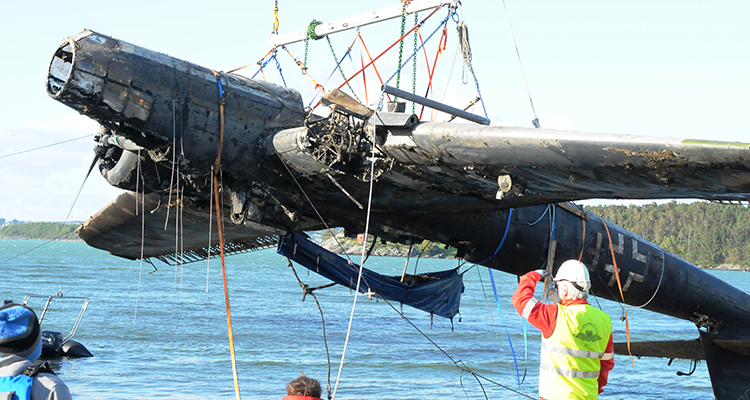“The museum has yet to decide whether this He-115 will be restored to nonflying display status or simply cleaned up and left as it was found”
On June 12, one of the best-preserved and least damaged of all World War II aircraft recovered from underwater, a Heinkel H-115B twin-engine floatplane, was gently brought to the surface of a Norwegian fjord near Stavanger and then craned ashore upside down, just as it was found. Not only was the airplane intact, the recovery effort, unlike many jerk-’em-out attempted saves, was carefully planned and carried out by the Sola Flyhistorsik Museum, which sits barely three miles from the recovery site.
The museum had already built and readied a huge tank of fresh water in which the He-115 will spend the next several years as, they hope, salt deposits leach out of lap joints and fittings where high-pressure hosing would never reach them. (Some experts feel that electrolytic treatment in a citric sulfate bath is the only permanent cure.) The tank is lighted from underwater and has three viewing windows, so museum visitors can see the entire airplane during the process. Fortunately, the Heinkel had lain for 70 years in a part of the frigid fjord that, though ocean-salty, has very low oxygen content, thus inhibiting corrosion. Contrary to popular belief, cold water offers no advantage in wreck preservation and in fact is probably worse for metal and wood, since it normally holds more oxygen.
Better yet, the airplane suffered little crash damage during a botched downwind landing on the day after Christmas 1942. The Heinkel slewed hard and snapped off its left float, then capsized but floated long enough for the crew to scramble out and mechanics to salvage one engine and the remaining float before it sank.
Though the big Heinkel is certainly historic, since no He-115 is on exhibit (much less flying) anywhere else in the world, it’s a stretch to say it’s an important find. Designed during the late 1930s, when not only the Germans but the British and Americans thought that slow, lumbering, lightly armed torpedo bombers would still be effective (only the Japanese got it right, with the fast and capable Nakajima B5N Kate), the He-115 couldn’t operate unless it was unopposed. Still, He-115s made their unfortunate mark on Anglo-American convoys heading for Murmansk, particularly during the weeklong air, surface and sub battering of the infamous Convoy PQ-17 in July 1942.
The museum has yet to decide whether this He-115 will be restored to nonflying display status or simply cleaned up and left as it was found (albeit right side up). Either way, a floatplane nearly the size of a DC-3 will make an impressive exhibit.





